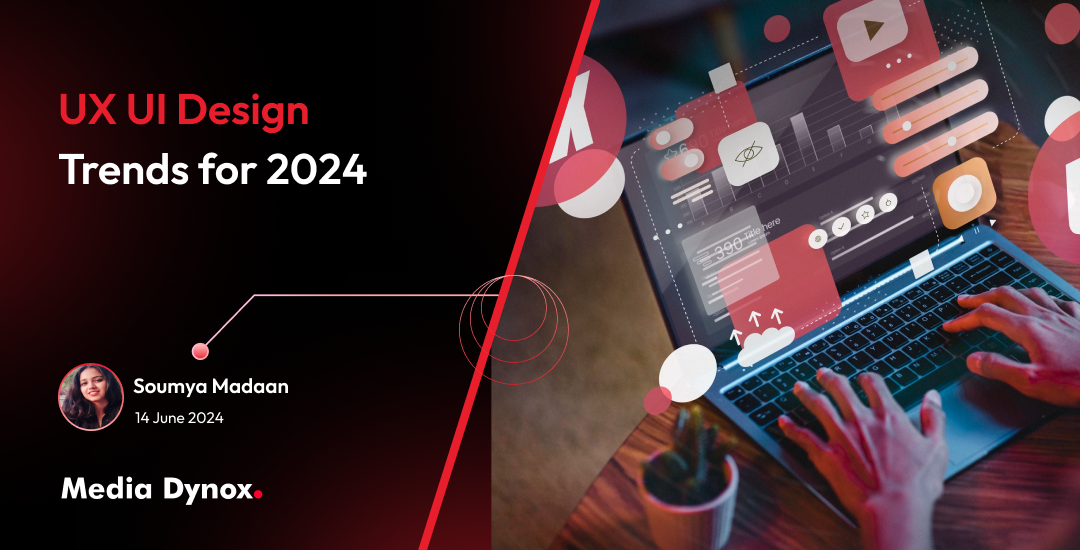
The user interface and experience of any digital product combine to define the user’s perception of the product. This is why, trying out new methods and technologies helps you give a fresh, never-seen-before kind of experience to your customers.
When you are successfully able to entertain your customers with your website, you have a higher chance of retaining them. Now that we are in an era where every day brings a new way to charm your customers, designing interfaces has become more interesting than ever.
So, it’s time for you to polish your skills with the latest UI UX design trends of 2024.
Top 10 UI/UX Design Trends 2024
The UI/UX design industry is now booming with new ways to create impactful user experiences. You can try your hand at either or a combination of these trends in your designs to deliver an all-new customer experience.
1. AI-Powered Personalization
Artificial Intelligence (AI) is changing both, the designing as well as interaction phases of a digital interface. AI-based personalization helps you find out about the user’s interests and give relevant recommendations. By using AI, you can analyze the end user’s preferences to create a more interactive design. You can use AI to customize the content, recommend products, and create overall effective interfaces.
2. Voice User Interfaces (VUI)
Voice technology is continuously growing as people are becoming used to the idea of speaking their requirements and having them delivered. This has been a result of voice assistants. So, as these AI assistants become more knowledgeable, you need to design interfaces such that they can easily be traced by AI. For this, you must design conversational flows and guarantee accessibility for easy voice interactions.
3. AR and VR Integration
Slowly, businesses from varying industries are adapting AR and VR technologies to their website or app interfaces. By using these technologies, you make the interface more engaging for users. As these technologies are known for building immersive experiences, using them raises your existing UX to a higher level. With an immersive experience, raising the retention rate of the website becomes easier.
4. Neumorphism
The neuromorphic trend in UI/UX designs is like a better version of minimalism. By using shadows and highlights, this style creates realistic interfaces. This style combines a light color palette, built up of low contrast colors with a sense of depth. As a result, the elements appear more interactive. But, you must use neuromorphism strategically so you do not end up overwhelming the users as sometimes the results can be complex.
5. Sustainability and Ethical Design
Many people are still unaware of the fact that they can promote sustainability through UI and UX. To do so, you must focus on designing an interface that uses less energy and reduces digital waste. Additionally, ethical design practices such as data privacy, inclusivity, and transparency are slowly being added to the list. This trend is an example of responsibility and accountability becoming involved in the tech industry.
6. Minimalism and Clarity
Even though neomorphic adds depth, minimalism is still an important trend in UX/UI design. Clean interfaces that have enough white space help users focus on the important elements and, as a result, improve their navigation. This trend focuses on clear, simple, and functional designs so that users can easily find the information they need. The minimalist design also makes the performance better as they load faster and are easier to use on different devices.
7. Dark Mode Optimization
Dark mode has become a popular feature in recent years. As a result, you must focus on optimizing your designs for the dark mode as well. Dark mode has grown far beyond inverting colors and now includes careful designing according to contrast, readability, and eye strain. An effective dark mode design can reduce the battery consumption of the screens and provide a more comfortable experience for low-light environments.
8. Micro-interactions
Micro-interactions are small animations that make the user experience better by providing immediate responses to user actions. The use of micro-interactions is important as they keep a user engaged even if the loading is delayed. Another benefit is the fact that they help in creating a smoother, more engaging user journey. Using well-designed micro-interactions allows you to guide a user through their journey and simultaneously craft a memorable experience.
9. Inclusive Design
Inclusive design is now a necessity. You must prioritize accessibility in your design to make sure that it is usable for everyone. This includes designing for screen readers, giving alt text for images, ensuring keyboard navigation, and focusing on color contrast. As a result, your design becomes easily usable for people with disabilities.
Conclusion
These UX/UI design trends show a balance between technology and user-centric designs. From AI-based personalization to sustainability, these trends focus on creating a more meaningful and effective user experience. As designers use these trends in their practice, they can design intuitive, accessible, and engaging experiences for all.